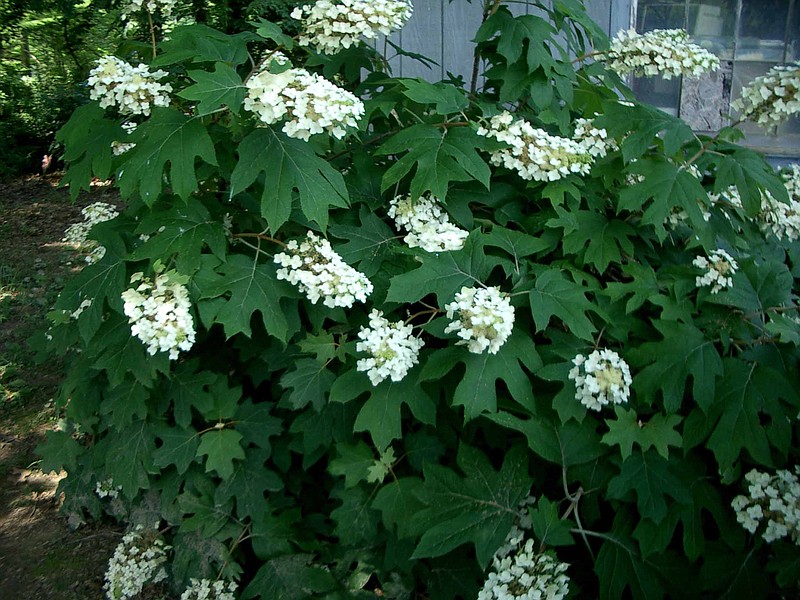Q: I have seven hydrangeas that just won't bloom. They look great, and they have looked like they're ready to bloom for two months; and I have like 12 flowers altogether. Once again, the ones I have look great. They grow on new wood, and it's about half-and-half between white and light blue color. They're about 4 feet tall and 3 feet wide, and they are planted very close together. I also have a crape myrtle that blooms nicely in the spring, and then they dry out in the summer. Also, I am watering regularly. We just moved here last year from another state and I am hoping you could give me some suggestions. I always enjoy reading your articles.
A: First, we need to determine what type of hydrangeas you have. There are two main types of hydrangeas commonly grown in Arkansas gardens — those that bloom on new growth, and those that bloom on old wood. In these categories, there are many options. Those that bloom on last year's growth (or old wood) are big leaf hydrangea and oakleaf hydrangea. The most common hydrangea is the big leaf hydrangea (Hydrangea macrophylla) with either mophead or lacecap blooms in shades of pink or blue. Oakleaf hydrangeas have oak-leaf shaped foliage with panicles of white blooms. Big leaf hydrangeas often get nipped back by a late frost or cold winter. If all their growth comes from the soil line (new growth), they will have very few late blooms. The big buds they set in the fall on the tips of the dead-looking stems during winter are where the huge flowers come from.
Because of the susceptibility to winter damage, new varieties called remontant (reblooming on both new and old wood) are becoming more common. These include Endless Summer, Blushing Bride and many more. They will bloom even if winter damages them; but the flowers will come on later and typically smaller. Panicle and smooth hydrangeas produce either white panicle or round white blooms in the summer on new growth. This year, because of the extreme heat, many of the panicles were smaller than normal, but they still bloomed. For your crape myrtle, try deadheading (cutting off the spent blooms) and see if that doesn't help them rebound and bloom again.
Q: Is it time to give up on our golden raintree? Ever since the polar vortex of two years ago nipped it in the bud, it has been losing big limbs. It used to be so thick and shady, and now it is just hollow when you look up. It put out three new twigs on the fork of a big dead limb; two died. We have loved and nurtured this tree for many years. We kept thinking it would bounce back. But what do you think of our poor tree? We are in Northwest Arkansas.
A: I am surprised the cold got the tree, since golden raintrees should be hardy even in much colder climates. As I see it, you have a few options. It is not as full and lush as it was, but neither is it dead. It is not in a location that could cause harm if it fell, nor is it large enough to do damage. You could continue to nurture it with water, fertilization in early spring, and wait to see what happens. Or you could replant another one nearby and let it grow for several years, until it has reached a good size, and then take this one out. I don't think this tree is going to die immediately, but sometimes, when they start losing limbs, it signals a slow death.
■ ■ ■
Q: I need advice. I got no fruit on my persimmon tree this year. That has never happened before. The tree is about 14 years old and looks very healthy. The leaves look great, and I cannot spot any disease. Is there something I need to do? This tree bears fruit that does not get astringent. I think it is an Oriental type. Something disturbed the blossom formation. Do I need to do something or see what happens next year? I am so disappointed because I really like the fruit, and last year we had about a bushel. Any advice?
A: Don't let one bad year of production worry you. Late frosts can get blooms; dry winters can do damage; wet springs can limit pollination; and some fruit trees can be "alternate bearing." One year they produce a bumper crop, and the next season they rest and recover. See what happens next year. If you still don't get any fruit, then investigate further.
Retired after 38 years with the University of Arkansas Cooperative Extension Service, Janet Carson ranks among Arkansas' best known horticulture experts. Her blog is at arkansasonline.com/planitjanet. Write to her at P.O. Box 2221, Little Rock, AR 72203 or email jcarson@arkansasonline.com
